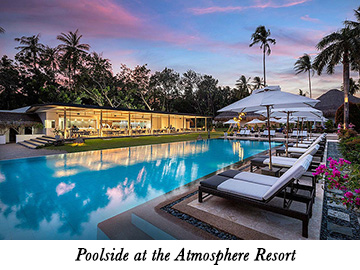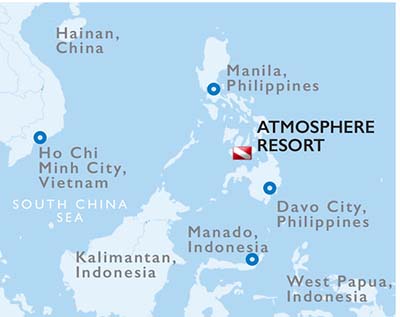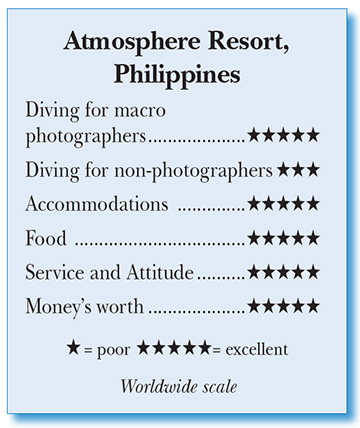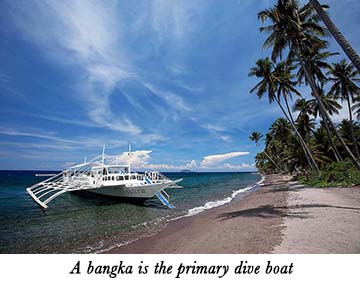Atmosphere Resort, PhilippinesContents of this Issue: Atmosphere Resort, Philippines Don't Ignore it My Friends: COVID Preys on Traveling Divers What Happens to Your Unwanted Neoprene Products? Mexico's Guadalupe Closed to Great White Diving Golden Rock Dive Center, St. Eustatius Ferry from St. Martin to St. Eustatius or Saba? Rude Divers - a Dive Center's Perspective Unexplained Snorkel Deaths in Hawaii SIPE - Be Aware of the Symptoms Editorial Office: Ben Davison Publisher and Editor Undercurrent 3020 Bridgeway, Suite 102 Sausalito, CA 94965 primo macro, fine wines from the September, 2022 issue of Undercurrent
Dear Fellow Diver, Just because "muck" rhymes with "yuck" doesn't mean that a mucky dive site is dirty, smelly, or disgusting. When "muck diving" was first named more than 40 years ago by the iconic Aussie Bob Halstead, he was shooting tiny critters in Milne Bay, Papua New Guinea, on the silty, sandy sea floor, not on the reefs or bommies. Today, macro shooters enthusiastically pursue muck because the many inhabitants are highly photogenic, and at Atmosphere Resort, muck critters abound. Most sites are less than 20 minutes away from the private beach of this surprisingly luxurious boutique resort, 400 miles south of Manila. For about $400/day, double occupancy for room, board, and diving (depending on room and season), it's quite the deal.
Upon reaching the mucky bottom, our dive leader, Saimon, pointed out small, colorful critters that were wonderful macro subjects. Saimon, who started at the resort 10 years ago, is a PADI divemaster, as are the other leaders, Arjay and Michael. On a single dive, I patiently photographed a seahorse, a frogfish, and a nudibranch. In the Caribbean, I'd be lucky to see just one of these critters once in a week. During other dives, I spotted several species of frogfish, seahorses, shrimp, and nudibranchs, as well as a pipefish and a few interesting reef fish such as Moorish idols and anemone fish. I was delighted to discover both a mimic octopus and the deadly blue ring octopus -- one bite can kill a person -- and even a 5-foot olive sea snake. I never saw big stuff like sharks, mantas, or dolphins. They're rare in these waters, though the Atmosphere offers 1.5-hour trips to Cebu to snorkel with whale sharks. In addition to the 50-foot bangkas, Atmosphere has a couple of 30-foot speed (but by no means speedy) boats. The bangkas have a head and plenty of covered area for staying out of the scorching sun, while the speed boats have canvas tops but no seats, so divers sit on the side rails during the ride and back roll to enter the water. After each dive, the crew handed me a moist, warm face towel and a large beach towel and then passed around a plate of fresh fruit. On the bangka, the guys happily make coffee, tea, or hot chocolate, which they call "choco." Upon return after a dive, a white-shirted waiter greeted us on the beach with a tray filled with glasses of fresh, chilled fruit juice. The meals at Atmosphere Resort were, hands down, the best I've had at endless dive resorts, and my dive mates shared my opinion. We ate in the well-appointed ocean-front dining room, open on two sides, so a breeze boosted by several ceiling fans made it comfortable during the hottest time of the day. They offered vast and varied menus for breakfast, lunch, and dinner (you can review them on their website), with various choices that rivaled those of a fine U.S. restaurant. Attentive, hardworking staff served all meals. Chef's specials at both lunch and dinner included such choices as a prosciutto-wrapped chicken filet with creamy garlic gnocchi with sundried tomatoes and spinach. Desserts are made in Atmosphere's on-site bakery and include several ever-changing flavors of homemade ice cream, baked treats, and decadent chocolate offerings. They carried more than 80 wines from all over the world, storing them in a climate-controlled wine cellar tended by a knowledgeable and personable sommelier, Eduardo. I indulged in some wonderful French wines. Although I assured my fellow divers I never overindulge, one morning on the boat, I asked the crew to make me some coffee before the dive.
The covered dive center is open on two sides, so it was always comfortable for checking gear and putting on wetsuits. Its boutique has little other than T-shirts and some artifacts, not even toothpaste or sunscreen. Basak is another good site, with the standard mucky bottom that slopes off deeper than recreational limits. In the 40- to 60-foot range, this site contains many interesting things to shoot. With Saimon's help, one diver took a much-sought-after picture of a cardinal fish with eggs in its mouth. At times Saimon might point out a critter I did not want to shoot, perhaps because it was too small and I had the wrong lens or because I already had enough shots of the subject. I signaled "no thanks," and he promptly found another subject. He and the other guides are the kind of professional leaders a macro shooter really appreciates and respects. Toi-Toi is similar to Basak, except that it begins with a grassy area before giving way to the ever-present muck. Seahorses and Halimeda ghost pipefish lingered in the grass, a natural camouflage from predators. Our sharp-eyed dive leaders were not fooled by this camo and quickly found and pointed out the critters. Even though I like to think I could have found them myself, I probably would have missed most of them were it not for the eagle-eyed dive leaders. In the afternoons, the air rose to the low 90s. Add 77 percent humidity, and it was too hot and sticky to walk around the attractive palm-studded grounds, but a swim in one of their beautiful pools could be refreshing.
As one would expect at such a high-end hotel, the design and personal service of the small diving operation were tops. After putting my gear in a numbered crate at the beginning of the week, they carried it back and forth to the boat, set it up, and afterward rinsed and hung my wetsuit in the large drying room, enhanced by the wise decision to vent the heat from the compressor into the drying room. At week's end, the staff gave my gear a more thorough rinse and -- I've never seen this before -- rinsed my BCDs both inside and out -- saving me the hassle of doing it back home in my bathtub. Another smart design is the rubberized lining for the four camera dunk tanks (and four others for rinsing gear) and two freshwater, open-air showers for rinsing divers. The well-lighted camera room, right off the dive center, contains about 15 working stations, each with four electrical outlets. While it is not air-conditioned, fans keep it at an acceptable temperature. Tanks always had at least 3,000 psi. For nitrox users, the guides gauged each tank before we left the dive center. Hauling the gear was not an easy task. As is typical in the Philippines, Atmosphere has no boat dock, and divers must wade out over an uneven gravel bottom into surging, waist-deep water and then walk up a 15-foot plank to board the boat. The only real downside to this operation: It was challenging to climb the plank, a good five feet off the water. But they provided a makeshift railing crewmembers held each end of a 15-foot-long, 4-inch-diameter bamboo stock that I could grab to steady my entrance and exit. I was in awe watching the staff walk it while toting tanks, dive gear, and heavy, bulky camera rigs.
By now, I hope you know the Atmosphere Resort is a beautiful hotel, the dive operation is first-rate, and if you're a macro photographer, you'll have it all. On the other hand, if you're not interested in shooting critters, you'd get pretty bored muck diving in low visibility for a week. And that's what many Philippine resorts offer. So, research your destination well. P.S.: Consider the Puerto Galera area, a favorite of Undercurrent readers who look for reefs, and Ken Knezick, the owner of Island Dreams Travel, a favorite of our readers, told us, "I remain a big fan of Puerto Galera, with El Galleon Resort and Asia Divers as my go-to dive resort. El Galleon is a very comfortable, accommodating, and affordable setup, offering a wonderful variety of dives within a 15-minute boat ride. The only longer trip is to Verde Island, which is beautiful coral reef diving. Access is easy: a flight to Manila, followed by car and boat transfers. https://www.islanddreams.travel See also: https://www.undercurrent.org/UCnow/dive_magazine/2022/ElGalleonResort202206.html --G.P.T. Our undercover diver's bio: Certified in 1983, I am a PADI Advanced Open Water diver with more than 1,000 dives from resorts and liveaboards in the Caribbean, Indonesia, Maldives, Red Sea, Mexico, Florida, California, and Hawaii. This was my third trip to the Philippines.
|

I want to get all the stories! Tell me how I can become an Undercurrent Online Member and get online access to all the articles of Undercurrent as well as thousands of first hand reports on dive operations world-wide
| Home | Online Members Area | My Account |
Login
|
Join
|
| Travel Index |
Dive Resort & Liveaboard Reviews
|
Featured Reports
|
Recent
Issues
|
Back Issues
|
|
Dive Gear
Index
|
Health/Safety Index
|
Environment & Misc.
Index
|
Seasonal Planner
|
Blogs
|
Free Articles
|
Book Picks
|
News
|
|
Special Offers
|
RSS
|
FAQ
|
About Us
|
Contact Us
|
Links
|
3020 Bridgeway, Ste 102, Sausalito, Ca 94965
All rights reserved.

 The deck of their primary dive boat, a 50-foot bangka (a double-outrigger Philippine boat), sits a good five feet above the water, so my first giant stride entry carried me deeper than I'm accustomed. (I got used to this, but a fellow male diver had to learn the hard way not to spread his legs too much during the drop.) After I surfaced. I looked down, but the bottom was not visible, not atypical for the Philippines. The visibility was a relatively low 15-20 feet at many sites, and the bottom is mostly featureless. But for my dive group, six Americans with cameras, none of that was a concern.
The deck of their primary dive boat, a 50-foot bangka (a double-outrigger Philippine boat), sits a good five feet above the water, so my first giant stride entry carried me deeper than I'm accustomed. (I got used to this, but a fellow male diver had to learn the hard way not to spread his legs too much during the drop.) After I surfaced. I looked down, but the bottom was not visible, not atypical for the Philippines. The visibility was a relatively low 15-20 feet at many sites, and the bottom is mostly featureless. But for my dive group, six Americans with cameras, none of that was a concern. A favorite dive site was Ginamaan (pronounced like "cinnamon" with a "G" My group audibly groaned when Saimon told us this site was an extensive collection of dumped tires, but we changed our tune when he explained the tires were placed more than 30 years ago. Three decades in the nutrient-rich water has produced a colorful growth on the tires, which attracts numerous critters. The tires are in several clumps, each about 10x10 feet, so I felt like I was swimming from reef to reef. Here I saw, among much else: seahorses, pipefish, nudibranchs, and shrimp, as well as some hard and soft corals. The low visibility was never a problem since my lens was just a few inches from the tiny subjects. By far, this was the most colorful site we dived, and we dived it three times by request. The water registered a comfortable 82 degrees, but I wore a 5mm wetsuit because I spent long periods staying stone-still to capture my subjects.
A favorite dive site was Ginamaan (pronounced like "cinnamon" with a "G" My group audibly groaned when Saimon told us this site was an extensive collection of dumped tires, but we changed our tune when he explained the tires were placed more than 30 years ago. Three decades in the nutrient-rich water has produced a colorful growth on the tires, which attracts numerous critters. The tires are in several clumps, each about 10x10 feet, so I felt like I was swimming from reef to reef. Here I saw, among much else: seahorses, pipefish, nudibranchs, and shrimp, as well as some hard and soft corals. The low visibility was never a problem since my lens was just a few inches from the tiny subjects. By far, this was the most colorful site we dived, and we dived it three times by request. The water registered a comfortable 82 degrees, but I wore a 5mm wetsuit because I spent long periods staying stone-still to capture my subjects. I would retreat to my lovely, modern Asian-inspired room, where I had full control of my air-conditioning and ceiling fan. I had a comfortable king-sized Asian-style bed, and a separate twin bed was also designed for sitting. I had a toilet room and a shower outdoors in a small private garden with 9-foot walls, where I could luxuriate in a hot or cold shower. The Philippines water is not potable for travelers, so my room staff kept a three-gallon dispenser full of purified water. I had free and adequate internet, but the resort requested that guests not slow it down by streaming movies; if you want to watch something, make it the broadcast channels on the room flat screen TV.
I would retreat to my lovely, modern Asian-inspired room, where I had full control of my air-conditioning and ceiling fan. I had a comfortable king-sized Asian-style bed, and a separate twin bed was also designed for sitting. I had a toilet room and a shower outdoors in a small private garden with 9-foot walls, where I could luxuriate in a hot or cold shower. The Philippines water is not potable for travelers, so my room staff kept a three-gallon dispenser full of purified water. I had free and adequate internet, but the resort requested that guests not slow it down by streaming movies; if you want to watch something, make it the broadcast channels on the room flat screen TV. One day each week is set aside to dive Apo Island, which is visible from the shore at Atmosphere and about a 45-minute bangka ride away. As we could see from our mooring, Apo is an economically depressed place without much attraction for tourists. Apparently, the waters had schools of fish not long ago, but when COVID hit, the fish became the primary source of food. During the lunchtime break, groups of women paddled out to dive boats moored off Apo to sell T-shirts. It's both inspiring and sad to see these middle-aged women paddling their small, two-person outrigger bangkas against the surface currents in the hope of selling a few T-shirts. We were informed of this the day before, so we all brought cash to buy their $7.50 T-shirts -- whether or not we needed one.
One day each week is set aside to dive Apo Island, which is visible from the shore at Atmosphere and about a 45-minute bangka ride away. As we could see from our mooring, Apo is an economically depressed place without much attraction for tourists. Apparently, the waters had schools of fish not long ago, but when COVID hit, the fish became the primary source of food. During the lunchtime break, groups of women paddled out to dive boats moored off Apo to sell T-shirts. It's both inspiring and sad to see these middle-aged women paddling their small, two-person outrigger bangkas against the surface currents in the hope of selling a few T-shirts. We were informed of this the day before, so we all brought cash to buy their $7.50 T-shirts -- whether or not we needed one. Hard corals are abundant in Apo's waters, and the visibility hit the 40- to 50-foot range, but the reefs are not particularly colorful or varied. The primary objective at Apo was to photograph turtles, and I was able to shoot them swimming in the open ocean, and, more challenging, lifting off from the bottom. Shots of resting turtles are reasonably easy to take but not particularly interesting unless the turtle is directly facing the camera, so it took effort to get an unusual shot. Here we had lunch on the boat between the second and third dive, but the typical dive routine at Atmosphere was a two-tank morning dive, back to the resort for lunch, and then a one-tank dive in the afternoon.
Hard corals are abundant in Apo's waters, and the visibility hit the 40- to 50-foot range, but the reefs are not particularly colorful or varied. The primary objective at Apo was to photograph turtles, and I was able to shoot them swimming in the open ocean, and, more challenging, lifting off from the bottom. Shots of resting turtles are reasonably easy to take but not particularly interesting unless the turtle is directly facing the camera, so it took effort to get an unusual shot. Here we had lunch on the boat between the second and third dive, but the typical dive routine at Atmosphere was a two-tank morning dive, back to the resort for lunch, and then a one-tank dive in the afternoon. Diver's Compass: Philippine Airlines has nonstop flights to Manila from both JFK (16 hours) and LAX (14 hours) . . . Atmosphere is on Negros Oriental Island, an hour-plus flight from Manila, followed by a 30-minute van ride . . . My seven-night stay cost about $400/day/person, double occupancy, including roundtrip air from Manila to Dumaguete, the 50-minute van ride; all meals; a day trip to Apo Island; and three dives with no charge for nitrox . . . COVID-related entry requirements may be found at
Diver's Compass: Philippine Airlines has nonstop flights to Manila from both JFK (16 hours) and LAX (14 hours) . . . Atmosphere is on Negros Oriental Island, an hour-plus flight from Manila, followed by a 30-minute van ride . . . My seven-night stay cost about $400/day/person, double occupancy, including roundtrip air from Manila to Dumaguete, the 50-minute van ride; all meals; a day trip to Apo Island; and three dives with no charge for nitrox . . . COVID-related entry requirements may be found at 